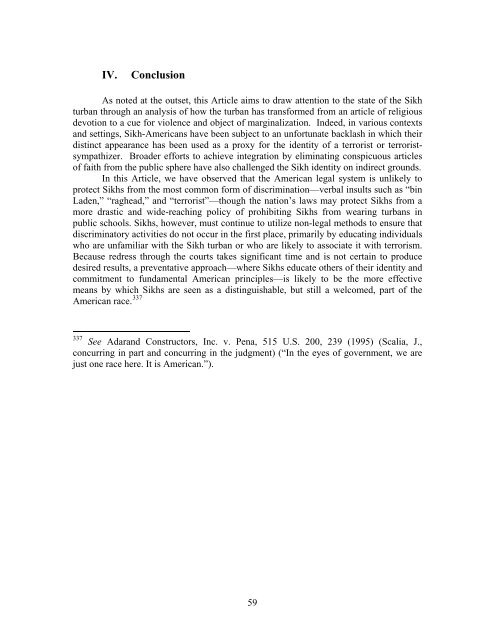The Sikh Turban: Post-911 Challenges to This Article of Faith
The Sikh Turban: Post-911 Challenges to This Article of Faith
The Sikh Turban: Post-911 Challenges to This Article of Faith
You also want an ePaper? Increase the reach of your titles
YUMPU automatically turns print PDFs into web optimized ePapers that Google loves.
IV.<br />
Conclusion<br />
As noted at the outset, this <strong>Article</strong> aims <strong>to</strong> draw attention <strong>to</strong> the state <strong>of</strong> the <strong>Sikh</strong><br />
turban through an analysis <strong>of</strong> how the turban has transformed from an article <strong>of</strong> religious<br />
devotion <strong>to</strong> a cue for violence and object <strong>of</strong> marginalization. Indeed, in various contexts<br />
and settings, <strong>Sikh</strong>-Americans have been subject <strong>to</strong> an unfortunate backlash in which their<br />
distinct appearance has been used as a proxy for the identity <strong>of</strong> a terrorist or terroristsympathizer.<br />
Broader efforts <strong>to</strong> achieve integration by eliminating conspicuous articles<br />
<strong>of</strong> faith from the public sphere have also challenged the <strong>Sikh</strong> identity on indirect grounds.<br />
In this <strong>Article</strong>, we have observed that the American legal system is unlikely <strong>to</strong><br />
protect <strong>Sikh</strong>s from the most common form <strong>of</strong> discrimination—verbal insults such as “bin<br />
Laden,” “raghead,” and “terrorist”—though the nation’s laws may protect <strong>Sikh</strong>s from a<br />
more drastic and wide-reaching policy <strong>of</strong> prohibiting <strong>Sikh</strong>s from wearing turbans in<br />
public schools. <strong>Sikh</strong>s, however, must continue <strong>to</strong> utilize non-legal methods <strong>to</strong> ensure that<br />
discrimina<strong>to</strong>ry activities do not occur in the first place, primarily by educating individuals<br />
who are unfamiliar with the <strong>Sikh</strong> turban or who are likely <strong>to</strong> associate it with terrorism.<br />
Because redress through the courts takes significant time and is not certain <strong>to</strong> produce<br />
desired results, a preventative approach—where <strong>Sikh</strong>s educate others <strong>of</strong> their identity and<br />
commitment <strong>to</strong> fundamental American principles—is likely <strong>to</strong> be the more effective<br />
means by which <strong>Sikh</strong>s are seen as a distinguishable, but still a welcomed, part <strong>of</strong> the<br />
American race. 337<br />
337 See Adarand Construc<strong>to</strong>rs, Inc. v. Pena, 515 U.S. 200, 239 (1995) (Scalia, J.,<br />
concurring in part and concurring in the judgment) (“In the eyes <strong>of</strong> government, we are<br />
just one race here. It is American.”).<br />
59
















